Using paleo-ecological information within biostratigraphic data may lead to new play concepts and prospects.
Oscar A. Abbink, TNO, The Netherlands
The main exploration objectives in the Netherlands are Permian gas reservoirs, but hydrocarbons occur in almost all stratigraphic intervals. However, after roughly 50 years of extensive exploration, the Dutch on- and offshore form a mature exploration area. New play development concepts rely on the integration of existing information and innovative techniques.
The Upper Jurassic to Lower Cretaceous strata have been a target for oil and gas exploration in the Netherlands for several decades. During the initial stages of Dutch offshore exploration history, various oil fields and some gas fields were discovered, of which only the F3-FB Field proved to be economic. In the Dutch northern offshore, uppermost Middle Jurassic (Callovian) to lowermost Cretaceous (Ryazanian), or the so-called Upper Jurassic, strata are limited to the Central Graben and Terschelling Basin, Fig. 1. The geology of these non-marine to shallow marine strata is complex, with a combination of lateral facies changes, repetitive log and facies characteristics in time, sea level and climate changes, salt tectonics and structural differences that hamper straightforward seismic interpretation, log correlation and stratigraphic understanding.
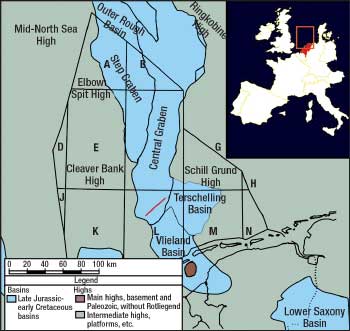 |
|
Fig. 1. The northern part of the Dutch offshore with the main Late Jurassic structural elements. The seismic line from Fig. 4 is indicated in red.
|
|
METHODOLOGY
There are about 150 released wells in the study area, and TNO, the Netherlands Organization for Applied Scientific Research, has biostratigraphically studied most of these wells. In addition, sedimentological, lithological and limited seismic information contributed to the used dataset. Detailed, high-resolution stratigraphy of these sequences has become a necessity both in predictive geological exploration models and in production reservoir models. In these paralic sequences, spores and pollen (sporomorphs) derived from land plants are the most abundant microfossil group. Based on actualistic principles, the presence of distinctive ecological groups (eco-groups) is assumed, each of which is characterized by taxa with broadly similar ecological preferences. Changes within and between the eco-groups can be used to recognize climate changes and sea-level fluctuations.
In this way, the sporomorph data can be used to recognize depositional sequences, including Maximum Flooding Surfaces (MFS), in shallow marine to even non-marine settings. In addition, the model provides reconstruction of a number of relatively distinct climatic shifts. These shifts form the boundaries of specific climate intervals and are considered isochronous for the Dutch territory. The high-resolution climatic shifts together with the MFS form a reliable and consistent correlation tool.
These new biostratigraphic techniques and recently acquired stratigraphic data have led to the identification of a series of events that can be related to the tectonic, climatic, environmental and stratigraphic development of the Upper Jurassic.
TECTONO-STRATIGRAPHIC SEQUENCES
Based on the used dataset created from biostratigraphic, sedimentological and lithological studies and limited seismic, three tectono-stratigraphic sequences can be recognized, Fig. 2. These sequences are punctuated by, at least, two significant MFSs per sequence.
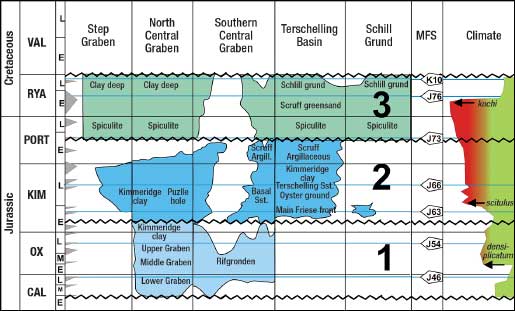 |
|
Fig. 2. Tectono-stratigraphic sequences with key lithostratigraphical units, maximum flooding surfaces and paleo-temperature curve.
|
|
- Sequence 1 (Middle Callovian to earliest Kimmeridgian) is formed by the inception of the Dutch Central Graben. Sediments are mainly fluviatile to very shallow marine, while the climate is interpreted as cool tropical.
- Sequence 2 (Early Kimmeridgian to Early Portlandian) involves renewed sedimentation in the Central Graben and the first sedimentation in the Terschelling Basin. This interval begins as non-marine, but marine conditions are established relatively rapidly. Within this interval, the beginning of a marked, Late Jurassic, arid phase is present.
- Sequence 3 (late Early Portlandian to Ryazanian) is characterized by the inception of all Upper Jurassic basins and overstepping of the previous basin margins. The arid phase ended within this sequence, and the climate returned to wet, tropical conditions (“Wealden” facies).
PLAY CONCEPT
These insights have direct impact on the exploration potential of the Dutch offshore and provide an explanation for the existence of only one economic oil field and the placement, or misplacement, of exploration wells.
The source rock for this play is formed by the directly underlying, Early Jurassic high-total organic carbon shale of the Posidonia Formation. Claystone intervals in the Kimmeridgian or the Ryazanian may also contain source rock-quality beds.
Thickness maps of Sequence 1 show that the present-day highs were also highs or incipient highs in Late Jurassic times, Figs. 3 and 4. Therefore, it may be concluded that the major fluviatile axes were situated in the lows between the highs. Consequently, the most sand-prone interval of the paralic/fluvial deposits would also be situated in the lows, Fig. 5. This implies that the main reservoirs are located in the central basin axes and are formed by the individually stacked channel sandstone bodies.
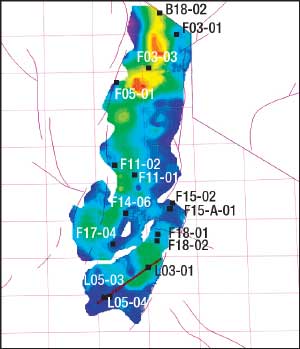 |
|
Fig. 3. An approximate thickness map of Sequence 1 in the Dutch Central Graben. Note the presence of most wells on the structural highs, apart from well F03-03, which is located in the only producing offshore oilfield.
|
|
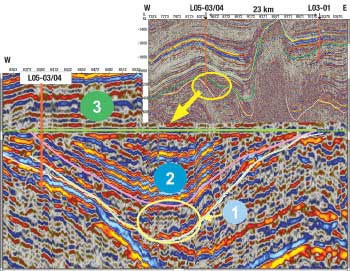 |
|
Fig. 4. Seismic profile of the L05-03/04 area toward L03-01 (W-E) showing the overall view (top right) and the details image (flattened on the base of Sequence 3; green line). The base of Sequence 1 is indicated with light green, and the base of Sequence 2 with pink. Sequence 1 thickens from the sides toward the center of the syncline. Onlap can be seen within the Sequence 1 basin center (light yellow oval).
|
|
The presence of several oil-water contacts above each other may indicate the existence of stratigraphic traps. The presence of multiple oil-water contacts has been recorded from, for example, the L05 wells, Fig. 4. Consequently, they are not the primary carrier bed for oil and gas to migrate upward to overlying reservoirs. In the deeper parts of the basin-the central river axes-the larger stacked fluviatile sandstones pinch out in the neighboring claystone sediments. In these configurations, an economically viable prospect for oil may exist. The clays within Sequence 1 are suggested to form the seal.
Almost all wells in the study area that penetrate Sequence 1 are located on present-day structural highs, Fig. 3. Although on a present-day high (turtle-back structure), the F03 oil field is situated in the basin axis where an increased sand content is present, i.e., in the basin center of Fig. 5. This supports the concept that during Sequence 1, more sand was deposited in the central, deeper parts of the Dutch Central Graben along the major fluviatile axes. This may explain why wells placed on structural highs have encountered only limited quantities of oil.
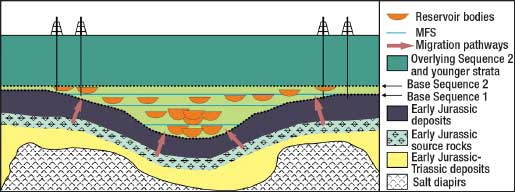 |
|
Fig. 5. A schematic diagram with explanation of the paralic/fluvial Sequence 1 stratigraphic-trap play.
|
|
CONCLUSIONS
The formation of the Dutch northern offshore Upper Jurassic led to a relatively complex geological setting. Within this setting, three distinct tectono-stratigraphic sequences can be recognized. Each sequence reflects a unique geological history. These sequences can be correlated with major changes in sea level, climate and environment, and are bounded by well-defined dis- and unconformities. This knowledge plays a key role in the exploration potential and provides a concept and model for the Sequence 1 stratigraphic-trap play.
The integrated approach with the use of high-resolution biostratigraphic, sedimentological, lithological, paleo-environmental and paleoclimatic data enables the reconstruction of the geological history. In particular, the use of a paleo-ecological model and integration of all tools to reconstruct the Upper Jurassic system have significant impact on the exploration models.
FUTURE OUTLOOK
Several operators have expressed interest in this play concept. Stratic Energy Ltd., London, has asked PanTerra Geoconsultants and TNO, both in the Netherlands, to study potential prospects in the Dutch Central Graben, based on the described paralic/fluvial Sequence 1 stratigraphic-trap play. Drilling may commence in early 2009. 
BIBLIOGRAPHY
Abbink, O. A., Targarona, J., Brinkhuis, H. and H. Visscher, “Late Jurassic to earliest Cretaceous palaeoclimatic evolution of the Southern North Sea,” Global and Planetary Change, 30, 2001, pp. 231-256.
Abbink, O. A., Van Konijnenburg-Van Cittert, J. H. A., Van der Zwan, C. J. and H. Visscher, “A sporomorph ecogroup model for the Northwest European Jurassic - Lower Cretaceous II: Application to an exploration well from the Dutch North Sea,” Netherlands Journal of Geosciences, 83, 2004, pp. 79-90.
Abbink, O. A., Mijnlieff, H. F., Munsterman, D. M. and R. C. M. Verreussel, “New stratigraphic insights in the ‘Late Jurassic’ of the Southern Central North Sea Graben and Terschelling Basin (Dutch Offshore) and related exploration potential,” Netherlands Journal of Geosciences, 85, 2006, pp. 221-238.
|
THE AUTHOR
|
| |
Oscar Abbink has 17 years’ experience in the E&P industry, with a background in biostratigraphy and exploration. In 2000, he joined TNO as geobiology manager and, since 2006, he has been manager of oil and gas. He earned an MSc in geology and a PhD in biology at Utrecht University, the Netherlands. He is presently involved in new exploration concepts and production optimization techniques.
|
|







